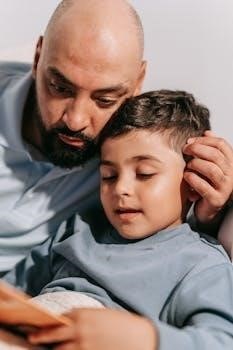The Edge of Seventeen⁚ A Parent’s Guide
This guide offers parents insights into “The Edge of Seventeen,” a coming-of-age film. It provides information on age appropriateness, themes, and potential discussion points. This will help parents decide if the movie suits their teenager and family values.
Overview of the Film

“The Edge of Seventeen,” directed by Kelly Fremon Craig, is a 2016 American coming-of-age comedy-drama. The film stars Hailee Steinfeld as Nadine, a high school junior navigating the complexities of adolescence. Nadine’s life takes an unexpected turn when her best friend, Krista (Haley Lu Richardson), begins dating her popular older brother, Darian (Blake Jenner). This event throws Nadine’s already turbulent world into further disarray, leading her to feel more isolated than ever.
The film explores themes of self-discovery, friendship, family dynamics, and the challenges of growing up. Nadine’s journey involves dealing with feelings of loneliness, social awkwardness, and the search for identity. Woody Harrelson plays Mr. Bruner, Nadine’s cynical but supportive history teacher, who provides her with much-needed guidance and humor. Kyra Sedgwick portrays Nadine’s mother, Mona, adding another layer to the complex family relationships depicted in the film.
The movie offers a poignant and often humorous look at the trials and tribulations of teenage life, capturing the emotional intensity and awkwardness of adolescence. It is a relatable story for anyone who has experienced the challenges of finding their place in the world.
Age Appropriateness and Rating
“The Edge of Seventeen” is rated R by the MPAA (Motion Picture Association of America). This rating signifies that the film contains material that may not be suitable for children under 17. Specifically, the rating is due to sexual content, pervasive language, and some teen drinking. Parents are strongly advised to be cautious and consider the maturity level of their teenager before allowing them to watch this film.
While some older teens may be able to handle the film’s content, younger viewers could find certain scenes and themes disturbing or inappropriate. The R rating serves as a warning about the presence of mature themes and potentially sensitive material. Parents should research the specific content of the film and consider their child’s individual sensitivities before making a decision.
Common Sense Media suggests a slightly older age for unsupervised viewing, highlighting the film’s mature themes and language. Ultimately, the decision of whether or not a teenager is ready to watch “The Edge of Seventeen” rests with the parent or guardian, based on their understanding of their child’s maturity, emotional resilience, and personal values. Considering these factors is crucial for a positive viewing experience.
Themes and Content
“The Edge of Seventeen” explores several significant themes relevant to adolescence. Primarily, it delves into the complexities of teenage relationships, showcasing the challenges of friendships, family dynamics, and romantic interests. The film portrays the awkwardness, insecurities, and emotional intensity that often characterize these formative years. Nadine, the protagonist, grapples with feelings of isolation and alienation as she navigates the social landscape of high school.
The film also touches upon themes of self-discovery and personal growth. Nadine’s journey involves learning to accept herself, flaws and all, and to develop a stronger sense of self-awareness. The narrative explores the importance of empathy and understanding in relationships, highlighting the need to look beyond surface appearances and consider others’ perspectives. Furthermore, the film addresses the challenges of dealing with grief and loss, as Nadine struggles to cope with personal setbacks and disappointments.
The content includes elements of dark comedy, reflecting the protagonist’s cynical outlook and sarcastic sense of humor. While the film aims to be relatable and humorous, it also acknowledges the emotional struggles and anxieties that many teenagers face. Parental guidance is advised to help teenagers process these complex themes.
Sexual Content
“The Edge of Seventeen” contains sexual content that parents should be aware of before allowing their teenagers to watch it. The film includes references to sexual activity and exploration among teenagers, reflecting the realities of high school life for some. While the film does not depict explicit scenes, it does address the topic of teenage sexuality in a frank and open manner.
There are instances of implied sexual encounters and discussions about sex, which may make some parents uncomfortable. The film also touches on issues of consent and healthy relationships. Characters navigate the complexities of physical attraction and emotional intimacy. It’s important to note that the film’s approach to sexual content is generally handled with a degree of maturity and realism, aiming to portray the challenges and uncertainties that teenagers face as they explore their sexuality.
Parents should consider their own values and comfort levels when deciding whether the film’s sexual content is appropriate for their children. Open communication with teenagers about these topics is encouraged to provide guidance and support. The film’s R rating is due in part to these elements.

Language
Parents should be aware that “The Edge of Seventeen” contains strong language throughout the film. The dialogue includes frequent use of profanity and coarse expressions, which reflects the way teenagers often communicate in real life. While the language is not gratuitous or overly aggressive, it is pervasive and may be offensive to some viewers. The film’s characters use strong language to express their emotions, frustrations, and insecurities, adding to the authenticity of their portrayals.
The level of language in the film contributes to its R rating, as it exceeds the standards for a PG-13 rating. Parents who are sensitive to strong language should consider this factor before allowing their teenagers to watch the film. It’s important to note that the language is used in a realistic context and is not intended to be glorified or condoned.
However, some parents may find the frequency and intensity of the language to be excessive or unnecessary. Ultimately, the decision of whether or not the film’s language is appropriate for a particular teenager rests with the parent or guardian. Discussions about the impact and appropriateness of such language can be valuable learning experiences.
Depiction of Alcohol and Drug Use
“The Edge of Seventeen” portrays teenagers engaging in underage drinking. The film includes scenes where characters consume alcohol, typically in social settings. While the film doesn’t explicitly endorse or glorify alcohol consumption, it depicts it as a common activity among some teenagers. The consequences of alcohol use are not heavily emphasized, but the film does not shy away from showing it. The characters, dealing with teenage problems, are not immune from the temptation to use alcohol.
Parents should be aware that the presence of underage drinking could potentially influence viewers, especially teenagers who are susceptible to peer pressure. The film’s depiction of alcohol use may normalize or desensitize young viewers to the risks associated with it. There is no explicit depiction of drug use in the film, and the focus remains on alcohol.
It is important for parents to have open conversations with their teenagers about the dangers of underage drinking and the potential consequences it can have on their health and well-being. The movie provides an opportunity for parents to discuss these issues with their kids after viewing.
Violence and Bullying
“The Edge of Seventeen” includes scenes depicting bullying, primarily within a school setting. The bullying portrayed is not excessively graphic but it does highlight the emotional impact of such behavior on the victim. One notable instance involves a young girl being physically knocked down by a group of boys. This scene, although brief, underscores the vulnerability of the victim and the potential for physical harm, even in seemingly minor incidents.
Beyond physical acts, the film also portrays subtle forms of bullying such as social exclusion and verbal taunts. These actions can have a significant effect on a teenager’s self-esteem and mental health. Nadine, the main character, experiences her fair share of social isolation and unkind remarks, which contribute to her overall sense of alienation and angst. The film demonstrates the importance of creating a supportive environment where bullying is not tolerated.
Parents should recognize that these bullying depictions are crucial for sparking conversations about responsible behavior, empathy, and the effects of bullying on individuals. The film serves as an opportunity to discuss the different forms bullying can take and the ways in which they can support those who may be experiencing it.

Emotional Intensity and Dark Themes
“The Edge of Seventeen” delves into intense emotional experiences and explores some darker themes prevalent in adolescence. The film opens with Nadine, the protagonist, expressing suicidal ideation, setting a tone for the emotional journey ahead. While she doesn’t act on these thoughts, their presence indicates the depth of her despair and feelings of isolation. The movie uses dark humor to manage these heavy topics, but the underlying seriousness remains apparent.
The film explores themes of grief, self-loathing, and loneliness. Nadine struggles with the complexities of relationships, the pain of betrayal, and the challenges of self-discovery. Her emotional reactions are often amplified by the hormonal fluctuations and heightened sensitivity typical of teenage years. This can lead to dramatic outbursts and impulsive decisions, which are depicted realistically in the film. These aspects of the movie may be challenging for some viewers, particularly those who have experienced similar struggles.
Parents should be aware of the potential emotional impact of these themes and be prepared to discuss them openly with their teens. The film can be an opportunity to explore mental health, coping mechanisms, and the importance of seeking help when needed. It’s important to emphasize that feeling overwhelmed or having dark thoughts is not uncommon, and there are resources available to support them.
Positive Aspects and Messages
Despite tackling difficult themes, “The Edge of Seventeen” offers several positive aspects and valuable messages for teenage viewers. The film ultimately highlights the importance of personal growth and self-acceptance. Nadine, the protagonist, undergoes a significant transformation as she learns to navigate the complexities of relationships and come to terms with her own flaws and insecurities.
The film promotes the idea of appreciating people’s motivations without immediately assuming malicious intent. Nadine initially misjudges many of the people in her life, but as the story progresses, she begins to understand their perspectives and motivations. This encourages viewers to be more empathetic and understanding in their own interactions.
Furthermore, “The Edge of Seventeen” emphasizes the value of genuine connection and the importance of seeking support from others. Nadine’s friendship with Erwin, despite its ups and downs, provides her with a lifeline and demonstrates the power of companionship. The film also showcases the positive influence of a supportive teacher, Mr. Bruner, who offers guidance and encouragement during Nadine’s difficult times.
Ultimately, the film sends a message of hope and resilience, suggesting that even in the darkest of times, personal growth and happiness are possible. It reinforces the idea that it’s okay to make mistakes, learn from them, and continue striving to become a better version of oneself.
Discussion Points for Parents

“The Edge of Seventeen” presents several opportunities for meaningful conversations between parents and teenagers. After watching the film together, parents can initiate discussions about the themes explored, such as navigating friendships, dealing with grief, and coping with feelings of isolation and insecurity. Encourage your teen to share their own experiences and perspectives on these issues.
The film’s portrayal of family dynamics can also serve as a starting point for discussing communication and understanding within your own family. Talk about the challenges Nadine faces in her relationship with her mother and brother, and explore ways to improve communication and resolve conflicts constructively. Ask your teen how they perceive their own role within the family and what they feel they need from their parents and siblings.
Furthermore, the film’s depiction of peer pressure and social expectations can lead to discussions about making responsible choices and resisting negative influences. Discuss the importance of staying true to oneself and not conforming to societal pressures. Help your teen develop strategies for navigating difficult social situations and making decisions that align with their values.
Finally, the film’s exploration of mental health can open up a dialogue about seeking help when needed. Emphasize that it’s okay to struggle with emotions and that reaching out for support is a sign of strength, not weakness. Discuss available resources and encourage your teen to talk to a trusted adult if they are experiencing emotional distress.
Critical Reception and Awards
“The Edge of Seventeen” garnered widespread critical acclaim upon its release, praised for its authentic portrayal of teenage life, sharp writing, and strong performances, particularly from Hailee Steinfeld as Nadine. Critics lauded the film’s ability to capture the complexities of adolescence with both humor and sensitivity, avoiding clichés often found in coming-of-age stories. The film currently holds a high rating on review aggregator websites, reflecting its positive reception.
Steinfeld’s performance was singled out for particular praise, with many critics considering it a career-defining role. Her portrayal of Nadine’s awkwardness, vulnerability, and wit resonated with audiences and critics alike. The supporting cast, including Woody Harrelson as Nadine’s dry-witted teacher, also received positive notices.
The film’s critical success translated into awards recognition. “The Edge of Seventeen” received nominations for several prestigious awards, including Critics Choice Awards nominations for Best Young Performer (Hailee Steinfeld), Best Actress in a Comedy (Steinfeld), and Best Comedy. While it didn’t win all of its nominations, the recognition underscored the film’s impact and quality.
The positive critical reception and awards attention further solidify “The Edge of Seventeen” as a noteworthy and well-regarded film within the coming-of-age genre. Its accolades highlight its artistic merit and its ability to connect with audiences on a meaningful level.
